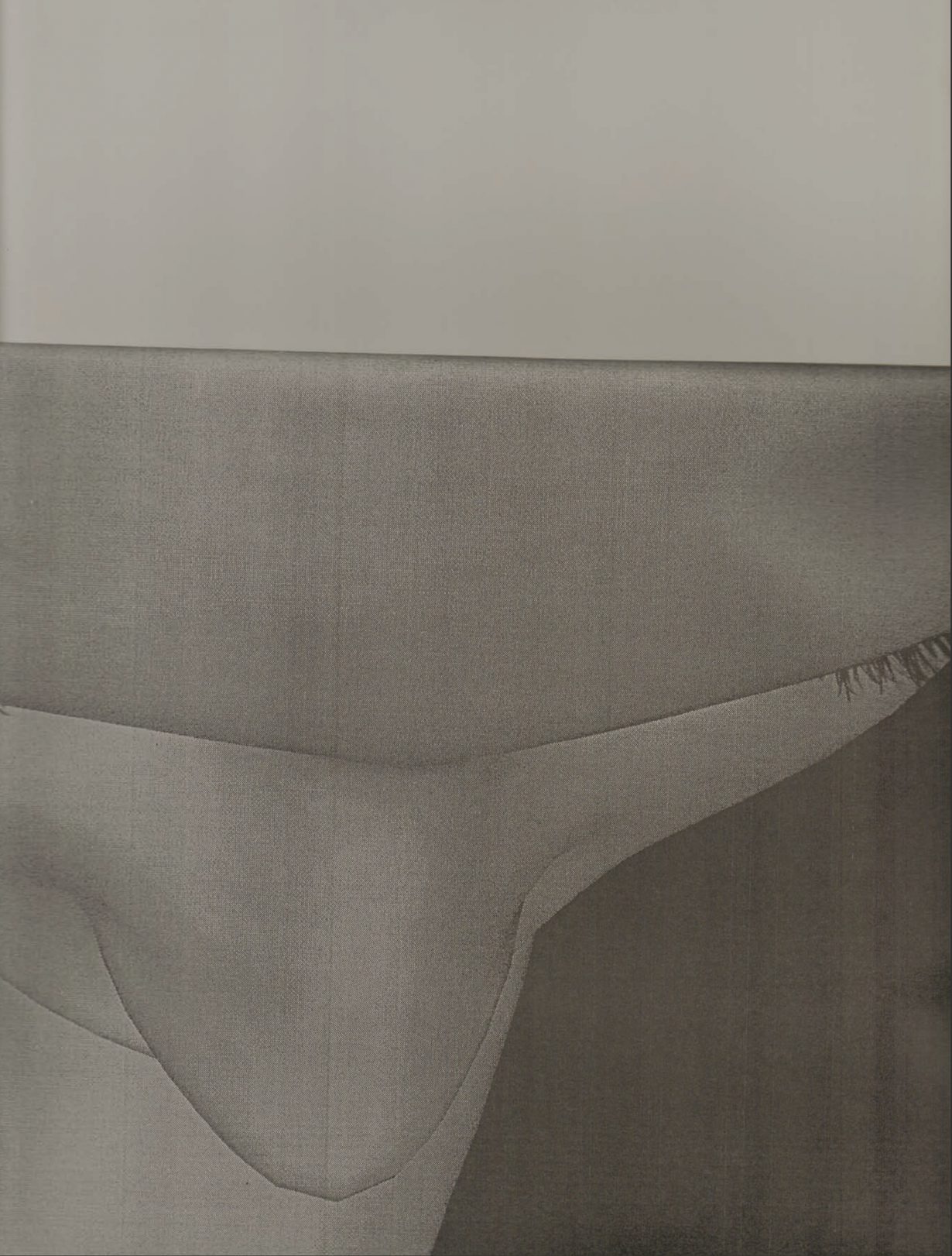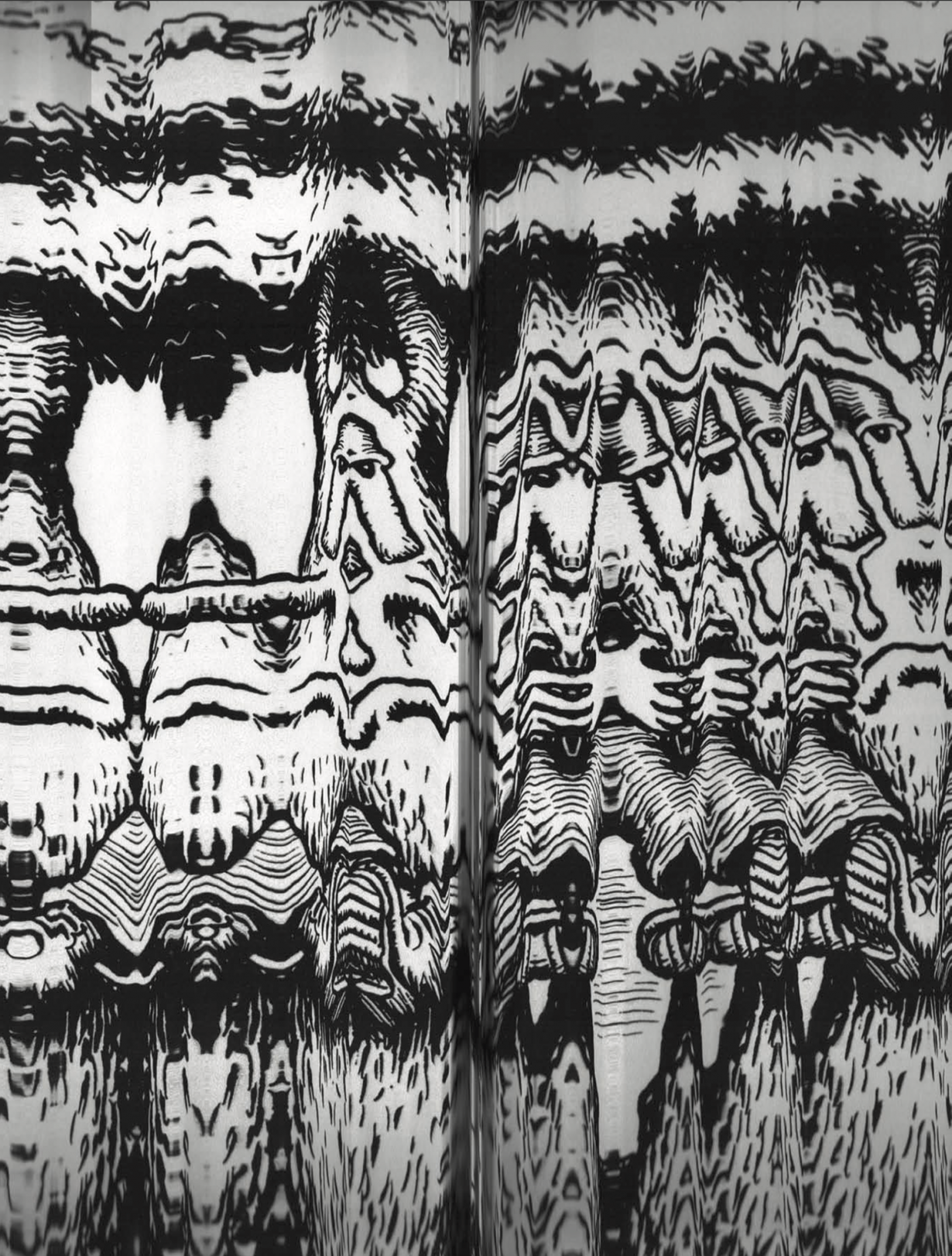There has been a fracturing within artists’ moving-image work in recent years, with divergent paths being tracked from within the medium. While much gallery-based work remains influenced by realist film, others, and particulary – to generalise – others of a younger generation, have embraced the digital aesthetic within their videomaking. Ideas regarding the conditions of a world that operates conjugally both online and off are now regularly funnelled through the kind of fluid, uncanny abstraction found in CGI, web memes and moving advertising. Ed Atkins’s and James Richards’s careers have run on parallel lines. Both have had much-praised exhibitions at London’s Chisenhale Gallery, both recently were awarded major funding prizes – Atkins the Paul Hamlyn Foundation Award and Richards the Jarman Award.
In 2011 they were asked to collaborate with artist Haroon Mirza on an independent commission to run alongside Performa 11, producing An Echo Button, a multichannel videowork shown on the big advertising screens in New York’s Times Square. Since being introduced through that project they have become studiomates, sharing and discussing their respective work on a daily basis. Though there are marked differences in their practices, both aesthetically and in terms of the interests that fuel them (Richards has a demonstrative interest in video’s historic avant-garde, while Atkins’s work is rooted in literature and art theory), there are nonetheless crossovers in their adoption of a socalled post-Internet practice (both remain suspicious of this term). Their work shares a dreamlike quality and interest in nonlinear narratives based on the use of found still and moving imagery, together with sound and music taken from anonymous Internet uploaders and other artists. Yet while both present a flattened version of cultural hierarchy – a YouTube video can share screen time with references to twentieth century structuralist filmmaking – each artist is at pains to affirm the status of his own authorship within the work.
The artist project that follows is constituted of images taken from works by Ed Atkins and James Richards; material that was then given to the other to be edited, reworked and played with in a series of exchanges.

ArtReview Ed, your work seems to have more of a traditional, narrative structure and has a basis in literature, whereas James, your videos have a tangential drift to them, which seems analagous to the way one navigates the Internet. Does this difference stem, in part, from how you approach the work’s production?
Ed Atkins James is very patient in his selection of images. I think I angrily edit, cutting and fighting against things, rather than allowing things to just be.
James Richards It’s interesting you say that. I was editing today, and I was thinking that my default mood when doing so is kind of meditative – detached, even. Which sounds negative, but I don’t mean it to be. Then there are moments – a configuration of sounds or images that feels emotionally urgent in some way – that puncture that, and real stimulation comes. That’s when I have something that can be in a work. I always feel like the starting point for a piece isn’t something I can verbalise, or predetermine. I start by looking into different sources – a stack of old DVDs, a folder of casually accumulated camcorder footage, some field recordings – and then the next step is to sift through them and glean.
EA Language is the first tool we use to deal with a thought. Writing is the easiest way to fill the gap between thinking of something and having it realised. Writing is an immediate answer to a problem. We both essentially operate with the same toolset, though. We both work in a way where we are simultaneously answering emails, waiting for things to render, listening to music. There is this perpetual drift to the way we work, which echoes browsing online generally. But I do feel guilty about that experience.

AR The Internet is a gluttonous thing: it can be all-consuming.
JR Knowing when to stop is a very old artistic problem. Having a certain restraint, knowing not to overdo things, is something that I hope to develop and refine with artistic maturity.
RA There is also a responsibility I think – which links with maturity too. Some areas of contemporary practice that involve found imagery have this sense of deniability, critically; if you critique the people who make this kind of work, they can always say, ‘Fuck it, it doesn’t matter, you don’t get it, you’re outside of this, so it’s clearly not for you.’ For me at least, the worst of it can fall into a critical vacuum: I can’t have a response to this other than ‘I’m in it’ or ‘I’m out of it’.
AR Are you talking specifically about post-Internet videowork?
JR I suppose to be working with the Internet you are always making work about distribution in some way, but to take that directly as the subject or aim doesn’t seem so interesting. This kind of post-Internet culture manifests itself in sculpture as well, though – producing sculpture in a similar way that one works with Photoshop – treating materials with the same sense of fluidity and interchangeability that is intrinsic to software.
EA There is a perversity in trying to make symptomatic artwork. In fact, it’s absurd to make one, because a symptom should be a symptom.
JR It’s a fetishisation. An artwork as an expression of blankness.

EA If you’re going to deal with post-Internet culture – and this probably relates to a sense of guilt about making art – you’d better be serious about it. There is tenderness to the way in which James works with a bit of footage, for example: an ability to know where to edit it in a way that doesn’t feel like a cut, a break, but is actually about nurturing a discrete moment. The responsibility I’m talking about is not of an arthistorical or intellectualised sort, but a proper investment in artmaking as an experience and an openness to sincere engagement.
AR We’re of a generation that can remember life before the Internet, but not in terms of our adult life. How generational do you feel your practices are?
JR We are on the cusp of that divide. My impulse would be to say that my work is not particular to a generation.
EA It’s so hard to discern that. Even if the Internet doesn’t have a direct relation to the work, its influence is undeniable. You really have to desperately opt out if you’re going to eschew any influence that the Internet might have on making work. You just can’t. Even our relationship to history is different now. Instead of linear, it seems to exist on a horizontal plane.
JR Yes, and I think the awareness of other people’s work is very high because of the Internet. But it’s an awareness of images alone, rather than work within a social context. You see work stripped of any context – knowing nothing about its author. I don’t want to say that’s bad, but it’s certainly a major change.

AR Both your works have quite a strong emotive resonance. James, you said before that you use ‘emotional tricks’.
JR That sounds like I’m trying to be more of a showman than maybe I am, but yes, there are devices and tropes that can be used to strike up emotions – and in making a work, I like being able to draw freely from these.
AR Even though there’s no traditional engagement in terms of a narrative or a character, you know where to put a soundtrack: you use a seductive piece of music, or you’re using a seductive image just at the right time to have a visceral pull. And Ed, the narrative that plays out in the work in your current Chisenhale show, Us Dead Talk Love, is a kind of romance, a love story. It has a tenderness. How do you address that in relation to digital aesthetics, which many people would associate with being cold or clinical?
EA I would hope that all art would have an emotional investment, and it’s just that we’re now able to talk about it, or we’re able to talk around it. There is a critical apparatus that can be wheeled in now to talk about affect, whereas previously maybe there wasn’t.
JR It’s sort of necessary, isn’t it? For me, art is about communication, and for me to really love a work it is necessary to have a sense of loving the person who’s made it. So the work is a vessel or a portal, no matter how bleak or tangential that is. You should be able to feel that there is an intention to communicate even if it’s totally abstracted; an underlying aim for art should be to map out a feeling. Similarly I like work that has a pretty simple making process – somehow written in – and which is allowed to be visible in the final work.
EA I think that’s the thing in regard to the technology, it actually serves to emphasise a real body and a real person in front of it more than it alienates the personality.

JR The craft inherent in Ed’s work is something that I really felt connected to when I first saw it and when we subsequently met. It’s about spending days crafting an artwork, working something up through playing and experimenting rather than fitting in with the postconceptual, poststudio, postmedium culture that was dominant at art school at the time we were both studying. For us, I think, making a video is a process of ‘doing’, of working out and trying to make sense of something in the same way that you have to with a painting or a sculpture.
EA I’ve always been fascinated whenever you get a set of emotional tropes and devices that, while we are aware they are applied to engender a particular response, still actually succeed in doing so. Like sentimentality, for example, and the use of effects that are clearly, bombastically, artificial in their sentimental aim. Similarly, art is about using artifice to confront a subject.
AR Artifice can have a real affect.
EA Absolutely. I mean, I’m obsessed at the moment with this Carl Dreyer quote, ‘Artifice to strip artifice of artifice’, which is really lovely. That’s a perfect description of a process through which you never get to a truth, so we can knock that on the head and forget that we’re ever trying to do that. But we can understand the strata of artifice and the way these things are constructed. Which is the same way in which structural devices somehow serve to actually allow a fragile, vulnerable thing to be glimpsed.
JR Well, I suppose it’s the same way that you use things like irony and humour to say things in speech and language that are very earnest, but are given enough deflection to get the point of something across without having to be totally direct about it. Likewise art is always a kind of deflection, isn’t it? It’s not necessarily a metaphor, but it’s a production of a thing that can pass something on. I think there is a connection to the interest in stock images – these sort of blank images that are made to be vessels for a text. They provide a certain openness that can be more comfortably embedded into an artwork.
From the December 2012 issue of ArtReview – explore the archive.